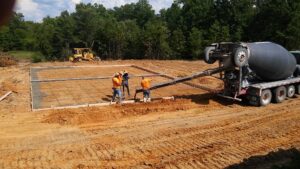Important Reminders for Pouring Concrete Slabs in Tulsa
Starting any construction project comes with challenges, especially when pouring concrete slabs. Whether you’re building a patio, driveway, or foundation in Tulsa, Oklahoma, getting it right requires expertise and preparation. This guide will walk you through key reminders to ensure success when pouring concrete slabs, considering Tulsa’s unique climate and conditions.
Why Proper Concrete Pouring Matters
Concrete slabs are the foundation of solid, durable structures. When done correctly, they ensure stability, safety, and longevity. However, poorly poured concrete can lead to costly cracks, structural issues, and repairs down the line.
For residents and businesses in Tulsa, Oklahoma, understanding the specific environmental factors that influence concrete pouring is essential. Extreme weather variations, from blistering summers to challenging freeze-thaw cycles in winter, can significantly impact the durability of your slab. Let’s ensure you’re set up for success.
Preparation Before Pouring Concrete Slabs
Choose the Right Type of Concrete
Selecting the correct concrete mix is crucial, especially in Tulsa. The mix needs to withstand local weather conditions. Consider:
- Strength: Opt for a concrete mix with adequate strength (measured in PSI). Residential projects generally require 3,000–4,000 PSI, while driveways may benefit from stronger mixes.
- Additives: For Tulsa’s unpredictable weather, consider including additives like air entrainment to enhance durability during freeze-thaw cycles.
Inspect and Prepare the Site
Proper site preparation is non-negotiable. Here’s what to do:
- Clear the area: Remove all grass, rocks, and debris to ensure a flat and stable site.
- Excavate to the right depth: Ensure you dig enough to accommodate the slab and any required subbase. Most slabs need 4–6 inches of compacted gravel.
- Add a gravel base: Gravel helps with drainage and keeps water from pooling beneath the slab.
Be Mindful of Permits and Regulations
Tulsa, like many cities, has specific building codes. Before you begin, check with local authorities for necessary permits or guidelines to ensure your project adheres to regulations.
Prepare Your Tools and Materials
Being ready with the right tools can save valuable time. Make sure you have:
- A concrete mixer or access to a ready-mix concrete delivery service
- Tamping equipment for leveling the ground
- Screeds, floats, and finishing tools
- Safety gear, like gloves and protective eyewear
Preparation is the key to avoiding delays and costly mistakes when pouring concrete.
Key Considerations During the Pour
Timing Is Critical
Tulsa’s summers can bring scorching heat, while winter temperatures can dip below freezing. Each extreme can affect how the concrete cures:
- Cold weather pouring (below 50°F): Use heated water in your mix and curing blankets to keep the slab warm during setting.
- Hot weather pouring (above 77°F): Consider starting early in the morning or late in the evening to avoid rapid evaporation, which can lead to cracking.
Reinforce the Slab
Reinforcement ensures your slab withstands heavy loads and resists cracking. The most common reinforcements include:
- Steel rebar in a grid pattern for larger slabs
- Welded wire mesh for smaller projects
Secure reinforcement in place before pouring to ensure it remains embedded in the concrete.
Pour with Precision
When it’s time to pour, do it steadily and methodically. Follow these steps:
- Spread evenly: Pour the concrete in sections to distribute it evenly across the site.
- Use a screed: Level the concrete immediately after pouring to avoid uneven surfaces.
- Eliminate air pockets: Vibrate or tap the surface lightly to ensure the concrete settles evenly without voids.
Post-Pour Steps for a Durable Slab
Finish the Surface
Once the concrete is leveled, you’ll want to add a finish. Tulsa’s weather can make certain finishes more practical than others:
- Broom finish for walkways and driveways to provide slip resistance.
- Smooth trowel finish for indoor surfaces that don’t require extra grip.
Avoid over-finishing, as this can weaken the surface and trap excessive moisture.
Curing Is Key
Curing is vital to prevent cracks and ensure durability. Follow these steps:
- Keep it moist: Concrete needs moisture to cure properly. Mist the slab regularly or use curing blankets.
- Protect from weather: Extreme heat or sudden rain can disrupt the curing process. Cover the slab with plastic sheeting if necessary.
- Allow time: Full curing typically takes 28 days, though the slab can handle light foot traffic within 24–48 hours.
Seal the Concrete
Given Tulsa’s freeze-thaw cycles, sealing your concrete is highly recommended. A good concrete sealer protects against moisture, UV damage, and stains. Apply the sealer once the slab has fully cured.
Common Mistakes to Avoid
- Ignoring Local Conditions
Tulsa’s climate presents unique challenges. Skipping steps like adding air entrainment or sealing the concrete can lead to cracks and other long-term issues.
- Rushing the Process
From insufficient curing time to improper site preparation, rushing any step in concrete pouring often results in costly repairs.
- Overmixing or Adding Excess Water
Adding too much water to the concrete mix may make it easier to pour but compromises strength and durability.
The Importance of Professional Assistance
Pouring concrete may seem like a simple DIY project, but its complexities often require professional expertise. Hiring an experienced contractor ensures the correct mix, proper reinforcement, and techniques tailored to Tulsa’s climate.
Building with Confidence in Tulsa
Pouring concrete slabs successfully in Tulsa, Oklahoma, takes careful preparation, the right materials, and an understanding of how local weather affects curing. By following these reminders, you can create durable and visually appealing concrete slabs that stand the test of time.
If you’re planning a project and feel unsure about tackling it yourself, consider reaching out to a professional for advice on materials, methods, and climate considerations. With the right guidance, you’ll set the foundation for a solid structure and lasting success.

